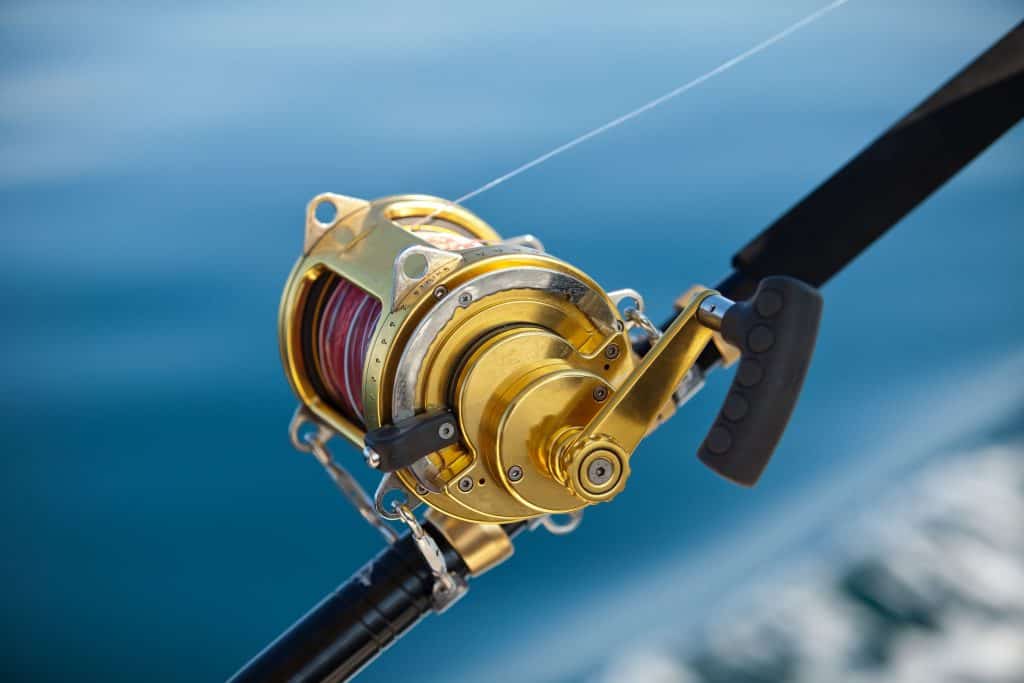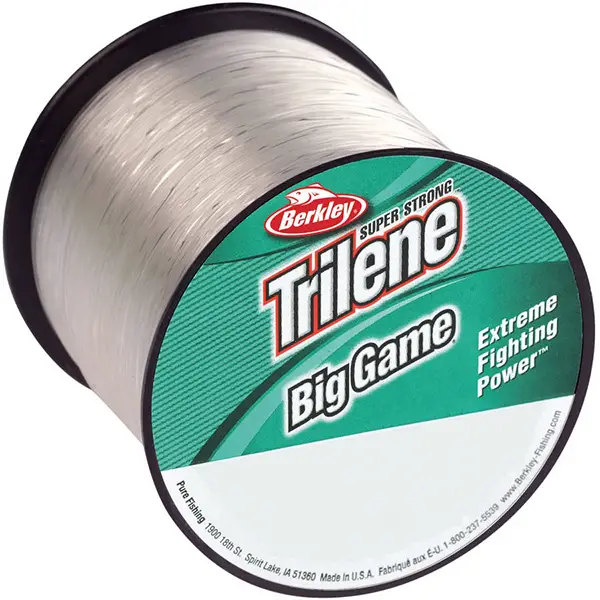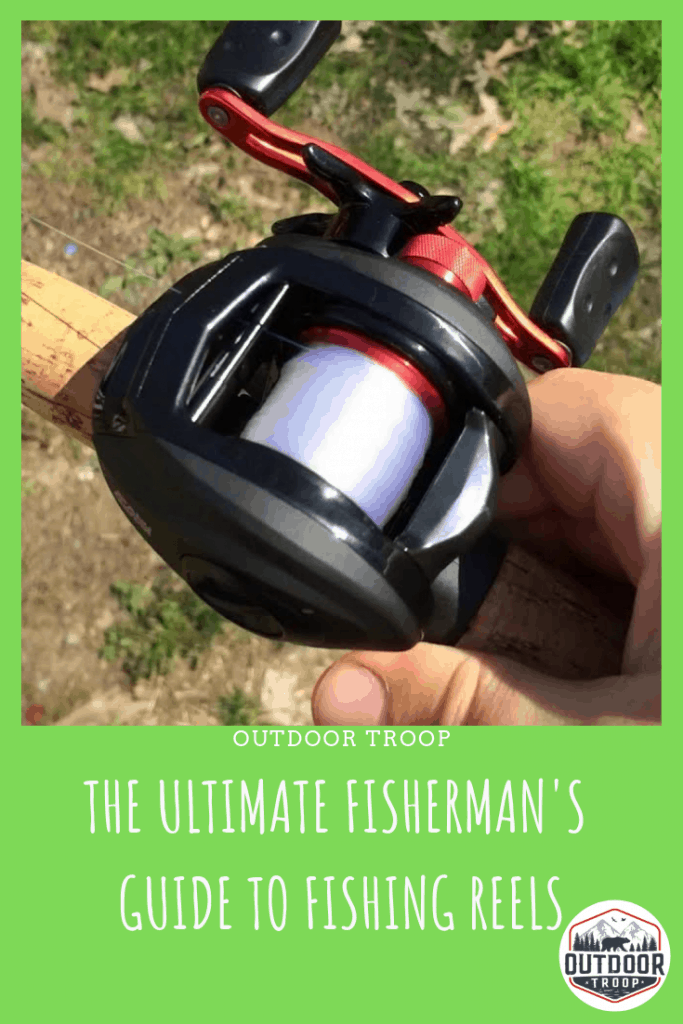
Fishing reels are the piece of equipment that controls the line length. They are the reason that fishermen can cast out hundreds of feet without the line tangling itself up.
They are also the hardware that keeps the fish fight real and exciting by giving tools and options to use in very specific situations. Without reels, fishing line would have to be brought in by hand, which can be tough with a big fish on the end.
They are the most technical piece of equipment in fishing setups but can be explained pretty easily.
There are four types of reels that will be discussed. They vary in advantages, some better at some things than others, but they all have their own disadvantages in some places.
The four main types of fishing reels are:
- Spin Reels
- Baitcasting Reels
- Spincasting Reels
- Fly Reels
Spin Reels
Spinning reels are named so because they do exactly what it says they do. When casting or retrieving, the reel will spin around and either collect the line or let it out.
Newer models of rods can make the line retrieval as silent as possible, making it undetectable to the fish. This works very well for lures and crankbaits.
Line Capacity
The capacity a reel can carry usually seems a lot more than what it seems like it should be able to carry. Most rods carry over 100 yards of line, and this can be just the right amount, especially if the fish fights for a while and pulls a lot of the line out.
Trying to tell how
6-200
8-150
10-120
The first number means that the line should be 6 lbs of monofilament line and you can have 200 yards of it. The next two lines show the capacity of 8 lb line and 10 lb line. This is only for monofilament lines. Other types of lines will either be smaller diameter and fit more, or have a larger diameter and be able to fit less.
| Braid | Monofilament | Diameter (inches) |
| 6 lbs | 2 lbs | .006 |
| 10 lbs | 4 lbs | .009 |
| 20 lbs | 6 lbs | .010 |
| 30 lbs | 8 lbs | .011 |
| 50 lbs | 12 lbs | .012 |
| 65 lbs | 17 lbs | .014 |
| 80 lbs | 20 lbs | .016 |
| 100 lbs | 25 lbs | .017 |
When spooling your own reel, make sure that you put as much as you can onto the reel without letting it curl out over the spool. This level can change with different diameters. Larger diameters will hop off the reel easier than small diameters.
Bearings
The ball bearing systems in spinning rods are legendary in working light lines when catching fish. The bearings keep the line running smoothly which helps the line retrieval stay silent and undetectable.
Look for rods that have quality bearings. It does not matter if the rod comes with ten bearings if they
Baitcast Fishing Reels

Baitcasting reels have a very different design as those of a spinning reel. The spool is perpendicular to the rod as opposed to the parallel designs of the spinning reels.
There are some serious advantages when using one of these rods. The line placement and just the different features of the reel make it seem like the superior rod, despite being difficult to master.
Line Capacity
The capacity of baitcasting reels
When switching line over to braid, refer to the table above. Be sure to fill the bait casting rod up until there is about an eighth of an inch left. Any more and your line will start to make a weird noise as it is cast out and retrieved.
It is important to be sure to fill the rod up with as much line as you can because there is nothing worse than maxing out the line in a big fight. It is stressful and just a bad experience.
Brake Systems
Brake systems. Notice the plurality of ‘systems.’ There are actually three built-in brake systems in the reel and another that will help you with sensitivity levels and control.
Centrifugal Brakes – When you cast out with a lure, the reel will spit out line at the same speed that the lure started out moving at. As the lure or baited hook slows down in the air, the line has the potential to bunch up behind the line and get tangled up. There is a brake system that prevents this. It releases the line to allow only the smallest amount of slack to appear on the line.
Magnetic Brakes – There are magnetic brakes on the side of the spool, and depending on the distance they are from the spool, they will allow the reel to let out line on the cast. This is just a precaution to the casting situation spoken of in the section above.
Spool Tension Adjustment – The last brake system is for the end of the cast and when giving line for the fish. The spool tension stops the line as the lure begins to be retrieved. When a fish is fighting too hard it might be necessary to give a little line. This mechanism can give the line, but still keep tension on the line, keeping the fish hooked
The last ‘brake system’ is your thumb. By pressing it down on the exposed part of the spool, you can effectively stop or slow down the line as you cast or as it’s pulled away from you. The other systems are designed to lower the amount of thumbing you will have to be doing, but it is still very useful to use your thumb.
There are a few precautions when using the last two, though. The Spool Tension Adjustment mechanism can sometimes wear down the reel to the point that it will break earlier than other results. Do not adjust it too high for too long else the wear can break it down.
For your thumb, the line can be moving pretty fast and, especially if it is a thinner line, the line can sometimes cut your thumb. It’s not often, but there is a possibility that your thumb can get shredded after a good day of fishing.
Spincasting Reel
The spin casting reel is different than the spin reel with its covered top and very different casting method than any other type of reel.
Line Capacity
Spincasting Reels have a fixed spool inside the covering, meaning that, for any reason, if the line length is reduced due to snags or cutting, there is a fixed limited amount of line that cannot be replaced.
There is little danger of the line coming off of the reel, so the spools hold most pound lines to the very max length the reel can hold. This solves a common problem with spin reels while having diameters able to be on it, just like the baitcasting reels.
Casting
Casting with these types of reels is different than the other types of reels, but is similar to the baitcasting reels. For a casting reel, there is a button on the underside of the reel that is pressed just before the cast. To release the line, release the button as the rod is moving away from yourself without letting go of the rod.
As the line is released, it will smoothly come out of the little hole on the top of the reel. After the line has hit the water, the reel will probably stop letting out line. This is when you start to reel in just a little to get the mechanism to lock up the line again.
The benefits of this
Fly Fishing Reels
Fly reels are designed to be specific to fly fishing to the exact point. The spool is positioned to spin and have the line not change direction as it leaves the reel, as it does with spin reels. The line acts more like a bait caster in this instance.
Line Capacity
The line capacity seems like it should fit more line since the reel is a lot bigger than other types, but since the fly line is so thick, it actually ends up holding about the same or a little less.
The line is pretty complicated, as there are three different types that go on the reel.
Fly line is made of a braided or nylon core that is then coated in PVC or a different substance that makes it float more or sink at varying rates. This is the main type of line on a fly set up, but there are only 100 feet on the reel. It is attached to the leader and to the backing.
The backing on a fly reel is not used in the casting process. Instead, it is used to fight a big fish. There are about 100 yards of backing on a regular fly rod, behind the PVC coated line that is used in the casting. The backing is around 20-30 lb weight line.
The leader is usually just monofilament line but has an important difference. The line is tapered down, starting at the bottom, the part that is attached to the fly line.
Lines
Besides the specifics of fly line, there are a few different types of line with advantages that can play into fishing for specific species. Some reels do better with different types of rods, while some line materials are better in a certain circumstance no matter the type of reel.
Monofilament Line – Monofilament line is a type of line comprising of completely one material. It is usually clear but can be purchased in different colors to more match the color of the water that you be fishing in. This can help with reducing the visibility of the line towards the fish.
The most common material used for monofilamet line is nylon. Sometimes different types of nylon are melted down together, which can result in different colors, strengths, and resistance to abrasion.
Monoline, as it is usually called, has a natural stretch to it that other types of lines cannot match. This can help especially when trying to set the hook. The stretch as the line absorbs some of the tension can help keep the line from being pulled out of the mouth of the fish.
Monoline has a larger diameter. This is both a benefit and a great hindrance. The large diameter means that it will be harder to break on structures like rocks or sunken man-made concrete objects. They will also be able to pull out of plants without breaking.
Mono is best used on baitcasting reels as they can handle the thicker diameters and still be effective.

Braided line – Dubbed ‘
The braided structure gives it a high resistance to being broken by pulling. This means that a spool of mono that has a breaking point of 8 lbs will have the same diameter of braided line with a 40 lb breaking point.
Because it can get so thin, it is very hard to see in the water. It is also thin enough to be able to cut right through any green plants that it might get caught in.
A big downside to braided line is that because it is so thin, most structures will be able to cut through the line. This makes it a dangerous line to use near abandoned buildings and underwater structures.
A great benefit braid has over mono is that it has no memory. It will not be able to hold its shape in the spool, meaning you can take it off the spool and it will still be straight. Mono will be curly and not be straight.
Braided line works well on any type of reel, but the spin reel performs its best with braided line. While casting light lures or heavier lures, the braid works better than mono.
Fluorocarbon – Fluorocarbon line is very similar to mono in looks. It usually comes clear, but can be bought in different colors to match the water. It has many advantages over mono but is very expensive when compared to mono or braided line.
Fluorocarbon line is stronger than mono and has less stress. The line can handle more stress as well, meaning that the differences in diameter per pound of breaking point is similar to the difference to mono and braid, but not as dramatic as braid.
Fluorocarbon line is extremely pricey, so having a while reel if it is somewhat unrealistic. Most anglers use it as a leader, the line that is in between the hook and the rest of the line. It is strong, heavier, and nearly invisible. Perfect for being right next to a fish.
Fluorocarbon line should rarely be used as a full reel. The line is too sturdy and resistant to bend. It sometimes messes up the casting, even though once it is in the water it outperforms all of the other lines, with the exception of braided line in sheer strength.

Fishing cannot be done without a reel and a bad reel can make the experience terrible. Make sure that the reel you have is the one that makes the most sense to the type of fishing that you want to be doing.
Related Questions:
Can a Spinning Reel be put onto Casting rod, or vice versa? It is possible, but it is not recommended. The way that the rods are set up is specifically pointed to a certain reel setup, so it sometimes will mess with the rod. It can be done, however. The rod will feel backward, but you can get used to that pretty easily.
Can a spinning reel be used on saltwater? Even though spinning reels are better for lighter lures, they work very well in salt waters, where the fish tend to be a little bigger. For some types of fishing, such as jigging, the ability to lift the bail and let line out is a very useful ability to have.

